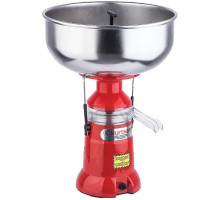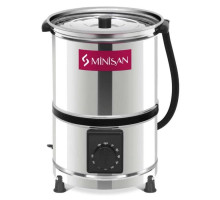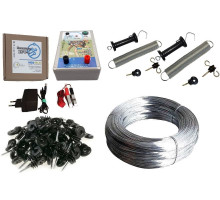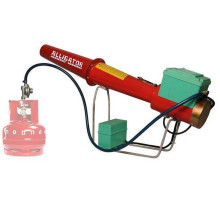How to choose an electric shepherd: Expert review of types, characteristics and popular models in Ukraine
Electric herders are a technology that is actively used in farming to control the movement of animals on pastures. The correct choice of this system depends not only on the preservation of livestock, but also on the efficiency of the use of land resources. How to choose the right electric shepherd, taking into account the type of animals, the area of the fence and the operating conditions? In this article, we will consider the main types of electric shepherds, the key technical characteristics that are worth paying attention to, and also review the most popular models on the Ukrainian market.
What is an electric shepherd and why is it needed?
An electric herder is an electric fence system that keeps animals within the pasture by means of a safe electrical impulse. It consists of several main elements: an electric generator (energizer), insulated wires or tapes, grounding and insulators. Animals that touch the fence receive a brief and harmless electric shock that deters them from further attempts to leave the area.
Why do farmers choose electric shepherds?
- Animal safety : the electric herder does not harm animals, but effectively keeps them in place.
- Mobility : the systems are easily dismantled and installed in new areas, which makes them convenient for seasonal use.
- Reduced fencing costs : Unlike traditional fences, electric systems are significantly cheaper and require fewer materials.
Types of electric shepherds: Features and purposes
There are several types of electric shepherds on the market, which differ in power source, power and purpose. Let's consider the main ones.
1. Electric shepherds on batteries
These models run on batteries or replaceable batteries and are suitable for pastures that are located far from electricity sources. This is the optimal choice for temporary detachments or remote areas.
Advantages:
- Independence from the power grid.
- Ability to work autonomously for up to several weeks.
Disadvantages:
- The need for regular replacement or charging of batteries.
- Limited capacity for large areas.
2. Electric shepherds on solar panels
Solar electric shepherds are an environmentally friendly solution that uses solar energy to power the system. They have built-in batteries that charge during the day and can work even at night or on cloudy days.
Advantages:
- Energy savings.
- Independence from the network.
Disadvantages:
- Dependence on the weather (efficiency decreases on cloudy days).
- Higher initial cost.
3. Electric shepherds from the power grid
These models work directly from the outlet and are ideal for large stationary enclosures with constant access to electricity.
Advantages:
- Stable operation without the need to replace batteries.
- High power, which allows you to serve large areas.
Disadvantages:
- Dependence on access to the power grid.
- Less mobility compared to battery and solar models.
Technical characteristics: What to pay attention to when choosing?
When choosing an electric shepherd, it is important to consider not only the type of power supply, but also several other key parameters:
1. Energizer power
Energizer is the "heart" of the system. Its power is measured in joules and determines how effectively the shepherd can restrain the animals. For small livestock, such as sheep or goats, a device with a power of 0.5-1 J is enough. For large animals (cows, horses), an energizer with a power of 1 to 3 J is needed.
2. The length of the fence line
Each model of the electric shepherd has a limit on the maximum length of the fence. For small areas (up to 10 km) compact models are suitable, while for large areas (up to 50 km and more) a more powerful system will be needed.
3. Number of wires
Electrical tapes or wires can have a different number of rows, which affects the efficiency of the system:
- For cattle, 2-3 rows are usually enough.
- For small livestock or especially active animals, it is better to use 4-5 rows.
4. Indication and control
Modern models are equipped with indicators that show the charge level and system performance. Some devices also support remote control functions using a smartphone or a special remote control.
Advantages and disadvantages of electric shepherds
Like any technology, electric shepherds have their pros and cons.
Advantages:
- Economical : electric shepherds are much cheaper to install and maintain than traditional fences.
- Mobility : the systems are easily moved, which is convenient for seasonal use.
- Safety : modern models ensure safe keeping of animals without harming them.
Disadvantages:
- Need for maintenance : You need to regularly check the performance of the system, charge the batteries or monitor the charge of the solar panel.
- Weather Dependency : Overcast weather can be a problem for solar panel models.
Popular models of electric shepherds in Ukraine
There are several models on the Ukrainian market that have earned the trust of farmers due to their reliability and efficiency.
1. Cowboy 8500 ultra magnum
This is one of the most powerful models that works from the mains and is suitable for large areas.
- Power: 8 J.
- The maximum length of the fence: up to 50 km.
- Works dsl 12 and 220V
- Suitable for cattle and sheep.
2. EPU-1
This model runs on solar batteries and is suitable for remote areas.
- Power: 0.7 J.
- The maximum length of the fence: up to 20 km.
- Can work from 220V, 12V and solar panels. Autonomy of work: up to 3 weeks without sun.
- Suitable for horses, pigs, cows
3. Corral N3500
Universal electric shepherd that can work both from the network and from the battery.
- Power: 3.5 J.
- The maximum length of the fence: up to 80 km.
- Suitable for small and large livestock.
Conclusion
Choosing an electric shepherd is an important step for every farmer who wants to efficiently keep livestock. The main selection criteria are the type of power supply, the power of the energizer, the area of the enclosure and the characteristics of the animals. The market of Ukraine offers a wide selection of models, so it is not difficult to find the optimal solution for any farm.













